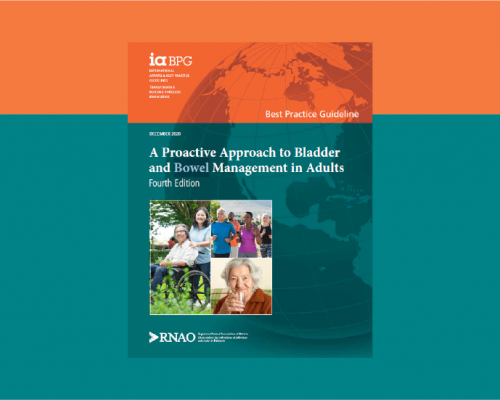
By: Heather Woodbeck, RN HB.Sc MHSA, LTC best practice co-ordinator
Urinary and fecal incontinence are often associated with an enormous amount of stigma. The literature notes this fear and shame results in many people suffering in silence and not seeking care. One study suggests that more than half of residents living with fecal incontinence in long-term care (LTC) homes did not seek help because they felt ashamed or had low expectations of what could be done. Staff attitudes that normalize incontinence in the LTC setting as part of the aging process limit the success of reducing incontinence rates and achieving optimal outcomes for residents. A few of the negative impacts for not properly managing incontinence effectively may include impaired skin integrity, diminished quality of life and lack of dignity.
It is important to address incontinence and eliminate the shame and stigma so that residents receive timely diagnosis and treatment. Increasing knowledge and awareness of urinary and fecal incontinence among health-care providers can break down barriers to residents obtaining better outcomes. A decrease in incontinence rates is a mandatory requirement in the Residents' Bill of Rights. Continence care and bowel management is also one of the requirements of Regulation 51 of the Long-Term Care Homes Act, 2007 and requires a quality improvement approach to care.
A Proactive Approach to Bladder and Bowel Management in Adults, Fourth Edition is an excellent addition to the field of urinary and bowel incontinence. This new best practice guideline (BPG) combines two previous RNAO BPGs, Promoting Continence Using Prompted Voiding and Prevention of Constipation in the Older Adult Population. This BPG can effectively support LTC homes in enhancing resident care and meeting the mandatory requirements for this required program. Monitoring elimination is crucial to the health of residents in LTC homes. A bowel obstruction or urinary tract infection can be life threatening.
RNAO is proud that the new BPG is endorsed by the major Canadian incontinence groups – the Canadian Nurse Continence Advisor Association, the Nurses Specialized in Wound, Ostomy & Continence Canada and the Simon Foundation for Continence. It is a comprehensive resource on incontinence topics. It is divided into two sections. The first covers urinary incontinence issues. The second discusses fecal incontinence and constipation. Evidence-based urinary and fecal assessments are provided. Interventions emphasize the latest evidence on exercise, fluids and fibre in treating incontinence. Welcome additions to the constipation section are the explicit recommendations for the use of the bulk-forming laxative — psyllium and bowel protocols.
The BPG has some great resources. A new format of incorporating resources directly related to each recommendation is used. The appendices are full of more excellent resources. Algorithms for urinary and constipation/fecal incontinence care are provided in appendix G and H. There are comprehensive lists of conditions and medications that can cause urinary incontinence. A sample voiding record, an in-depth assessment of urinary urgency and a prompted voiding protocol are included. Lists of risk factors for fecal incontinence, conditions and medications that can cause constipation are also provided. As well, included are the Bristol Stool Chart and a sample bowel record. New to the BPG is a Sample Bowel Protocol.
More resources on the new BPG can be found in the Continence Care and Bowel Management section of the LTC Best Practices Toolkit. There is an updated gap analysis to accompany the new bowel and bladder BPG.
